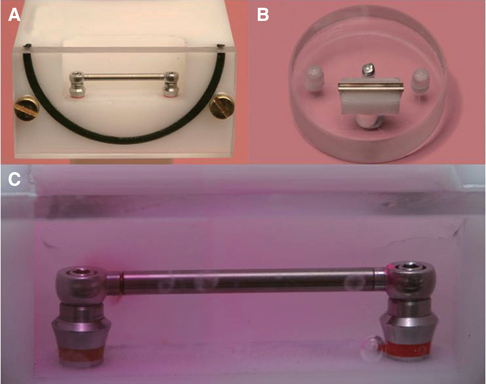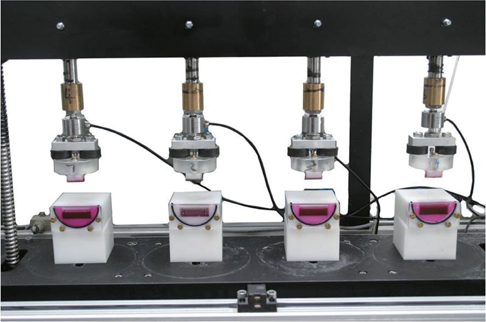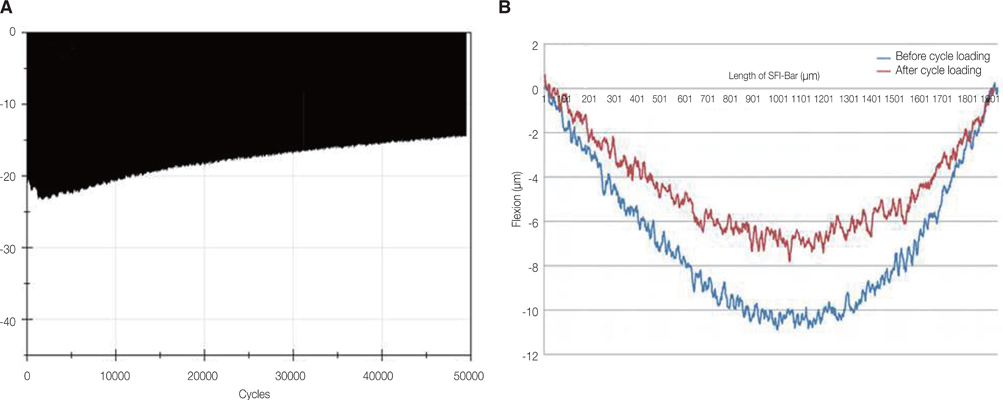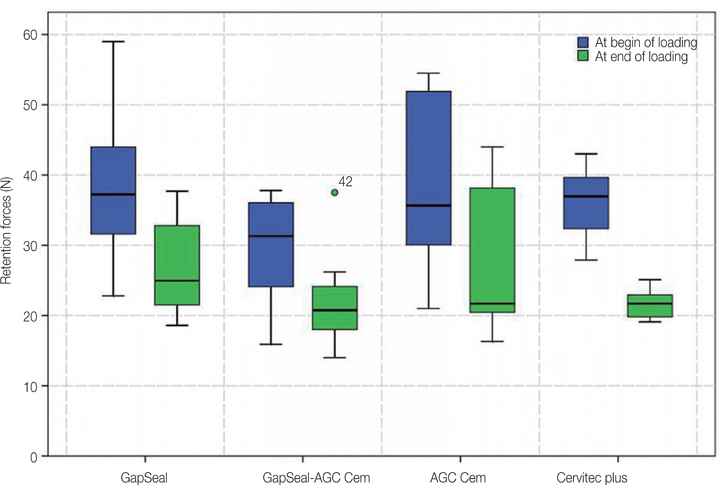J Adv Prosthodont.
2015 Aug;7(4):323-328. 10.4047/jap.2015.7.4.323.
Wear, microleakage and plastic deformation of an implant-supported chair-side bar system
- Affiliations
-
- 1Dental Material Sciences, Department of Prosthodontics, Propaedeutics and Dental Materials, Christian-Albrechts University at Kiel, Kiel, Germany. cmehl@proth.uni-kiel.de
- KMID: 2118269
- DOI: http://doi.org/10.4047/jap.2015.7.4.323
Abstract
- PURPOSE
This in-vitro study was designed to evaluate retention forces, microleakage and plastic deformation of a prefabricated 2-implant bar attachment system (SFI-Bar, Cendres+Metaux, Switzerland).
MATERIALS AND METHODS
Two SFI implant-adapters were torqued with 35 Ncm into two implant analogues. Before the tube bars were finally sealed, the inner cavity of the tube bar was filled with liquid red dye to evaluate microleakage. As tube bar sealing agents three different materials were used (AGC Cem (AGC, resin based), Cervitec Plus (CP; varnish) and Gapseal (GS; silicone based). Four groups with eight specimens each were tested (GS, GS+AGC, AGC, CP). For cyclic loading, the attachment system was assembled parallel to the female counterparts in a chewing simulator. The mean retention forces of the initial and final ten cycles were statistically evaluated (ANOVA, alpha< or =.05).
RESULTS
All groups showed a significant loss of retention forces. Their means differed between 30-39 N initially and 22-28 N after 50,000 loading cycles. No significant statistical differences could be found between the groups at the beginning (P=.224), at the end (P=.257) or between the loss of retention forces (P=.288). Microleakage occurred initially only in some groups but after 10,000 loading cycles all groups exhibited microleakage.
CONCLUSION
Long-term retention forces of the SFI-Bar remained above 20 N which can be considered clinically sufficient. The sealing agents in this study are not suitable to prevent microleakage.
Figure
Reference
-
1. Thompson GW, Kreisel PS. The impact of the demographics of aging and the edentulous condition on dental care services. J Prosthet Dent. 1998; 79:56–59.2. van Waas MA, Kalk W, van Zetten BL, van Os JH. Treatment results with immediate overdentures: an evaluation of 4.5 years. J Prosthet Dent. 1996; 76:153–157.3. Bergendal T, Engquist B. Implant-supported overdentures: a longitudinal prospective study. Int J Oral Maxillofac Implants. 1998; 13:253–262.4. Timmerman R, Stoker GT, Wismeijer D, Oosterveld P, Vermeeren JI, van Waas MA. An eight-year follow-up to a randomized clinical trial of participant satisfaction with three types of mandibular implant-retained overdentures. J Dent Res. 2004; 83:630–633.5. MacEntee MI, Walton JN, Glick N. A clinical trial of patient satisfaction and prosthodontic needs with ball and bar attachments for implant-retained complete overdentures: three-year results. J Prosthet Dent. 2005; 93:28–37.6. Zou D, Wu Y, Huang W, Wang F, Wang S, Zhang Z, Zhang Z. A 3-year prospective clinical study of telescopic crown, bar, and locator attachments for removable four implant-supported maxillary overdentures. Int J Prosthodont. 2013; 26:566–573.7. Albrecht D, Ramierez A, Kremer U, Katsoulis J, Mericske-Stern R, Enkling N. Space requirement of a prefabricated bar on two interforaminal implants: a prospective clinical study. Clin Oral Implants Res. 2015; 26:143–148.8. Petropoulos VC, Smith W, Kousvelari E. Comparison of retention and release periods for implant overdenture attachments. Int J Oral Maxillofac Implants. 1997; 12:176–185.9. Leung T, Preiskel HW. Retention profiles of stud-type precision attachments. Int J Prosthodont. 1991; 4:175–179.10. Dudic A, Mericske-Stern R. Retention mechanisms and prosthetic complications of implant-supported mandibular overdentures: long-term results. Clin Implant Dent Relat Res. 2002; 4:212–219.11. Naert I, Alsaadi G, Quirynen M. Prosthetic aspects and patient satisfaction with two-implant-retained mandibular overdentures: a 10-year randomized clinical study. Int J Prosthodont. 2004; 17:401–410.12. Naert I, Alsaadi G, van Steenberghe D, Quirynen M. A 10-year randomized clinical trial on the influence of splinted and unsplinted oral implants retaining mandibular overdentures: peri-implant outcome. Int J Oral Maxillofac Implants. 2004; 19:695–702.13. Ender A, Mehl A. Accuracy of complete-arch dental impressions: a new method of measuring trueness and precision. J Prosthet Dent. 2013; 109:121–128.14. Wee AG, Aquilino SA, Schneider RL. Strategies to achieve fit in implant prosthodontics: a review of the literature. Int J Prosthodont. 1999; 12:167–178.15. Deslis A, Hasan I, Bourauel C, Bayer S, Stark H, Keilig L. Numerical investigations of the loading behaviour of a prefabricated non-rigid bar system. Ann Anat. 2012; 194:538–544.16. Kobayashi M, Srinivasan M, Ammann P, Perriard J, Ohkubo C, Müller F, Belser UC, Schimmel M. Effects of in vitro cyclic dislodging on retentive force and removal torque of three overdenture attachment systems. Clin Oral Implants Res. 2014; 25:426–434.17. Ha SR, Kim SH, Song SI, Hong ST, Kim GY. Implant-supported overdenture with prefabricated bar attachment system in mandibular edentulous patient. J Adv Prosthodont. 2012; 4:254–258.18. Kim HY, Kim RJ, Qadeer S, Jeong CM, Shin SW, Huh JB. Immediate loading on mandibular edentulous patient with SFI Bar® overdenture. J Adv Prosthodont. 2011; 3:47–50.19. Bayer S, Grüner M, Keilig L, Hültenschmidt R, Nicolay C, Bourauel C, Utz KH, Stark H. Investigation of the wear of prefabricated attachments--an in vitro study of retentionforces and fitting tolerances. Quintessence Int. 2007; 38:e229–e237.20. Wolf K, Ludwig K, Hartfil H, Kern M. Analysis of retention and wear of ball attachments. Quintessence Int. 2009; 40:405–412.21. Harder S, Dimaczek B, Açil Y, Terheyden H, Freitag-Wolf S, Kern M. Molecular leakage at implant-abutment connection-in vitro investigation of tightness of internal conical implant-abutment connections against endotoxin penetration. Clin Oral Investig. 2010; 14:427–432.22. Fritzemeier C, Schmüdderich W. Prophylaxis of periimplantitis by sealing of the implant interiors with GapSeal®. Implantol. 2007; 15:71–79.
- Full Text Links
- Actions
-
Cited
- CITED
-
- Close
- Share
- Similar articles
-
- A THREE DIMENSIONAL PHOTOELASTIC STRESS ANALYSIS OF OMPLANT-SUPPORTED MANDIBULAR OVERDENTURE ACCORDING TO IMPLANT NUMBER AND ATTACHMENT TYPE
- Implant-supported milled bar overdenture with two implant surgical guides
- Rehabilitation using milled-bar with attachment maxilla overdenture in a patient with peri-implantitis fixed prosthesis: A case report
- A STUDY ON THE CHANGES IN RETENTION OF CLIPS USED TO RETAIN IMPLANT-SUPPORTED OVERDENTURE
- Implant-supported overdenture with prefabricated bar attachment system in mandibular edentulous patient







